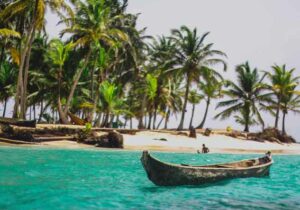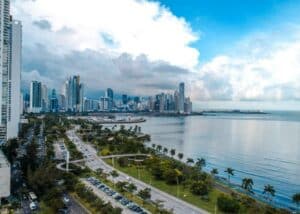Panama is a beautiful country and has long been recognized as one of the best destinations for retirees seeking a vibrant and affordable lifestyle. With a warm tropical climate, low cost of living, and attractive retirement benefits, it’s no surprise that so many expats are choosing to call this Central American gem home.
From Panama City’s modern comforts to tranquil beach towns and stunning highland retreats, the country offers a variety of living environments to suit all preferences. Retirees also benefit from favorable tax policies, world-class healthcare, and an easy residency process through the renowned Panama Pensionado Visa.
In this comprehensive guide, we’ll explore everything you need to know about retiring in Panama, including:
- Retirement visa options and application requirements
- Cost of living and tax benefits for foreign & American retirees
- Pros & cons of retiring in Panama
Whether in the early stages of planning or ready to move, this guide will help you confidently navigate the essentials of retiring in Panama.
Why Retire in Panama?

- Amazing Weather: Panama enjoys a tropical climate with warm temperatures year-round, making it ideal for those who love sunshine and outdoor activities. The country’s dry season (December to April) offers clear skies, while the rainy season brings lush greenery and cooler evenings.
- Beautiful Landscapes: From pristine beaches and turquoise waters to lush rainforests and towering mountains, Panama’s landscapes are incredibly diverse and breathtaking.
- Affordable Cost of Living: Panama offers a relatively low cost of living compared to many Western countries, with affordable housing, groceries, and transportation.
- Rich Culture and History: Panama’s culture is a vibrant blend of indigenous traditions, Spanish colonial heritage, and modern influences. From the historic Casco Viejo district to colorful local festivals and delicious cuisine, the country offers a rich cultural experience for residents and visitors alike.
- Convenient Location: Strategically located as a bridge between North and South America, Panama provides easy access to both continents. Its central location also makes it a hub for international travel, with Tocumen International Airport offering direct flights to major cities worldwide.
- Outdoor Adventures: Panama is a paradise for nature lovers and adventure seekers, offering activities like surfing, snorkeling, hiking, and birdwatching. With national parks, islands, and wildlife reserves, there’s always an opportunity to explore the great outdoors.
- Friendly Locals: Panamanians are known for their warmth, hospitality, and welcoming attitude toward foreigners. This makes it easy for newcomers to feel at home and build connections within the community.
- Stable Economy: Panama’s economy is one of the most stable in the region, driven by sectors like the Panama Canal, tourism, and banking.
How to Retire in Panama

It offers retirees an easy path to residency and many financial benefits. Designed to encourage foreign retirees to settle in Panama, this program provides substantial discounts on essential services, making it a highly cost-effective choice for expat retirees.
One of the biggest advantages of the Panama Pensionado Visa is that applicants are not restricted by age. Unlike some countries, which impose a minimum retirement age to qualify for special residency programs, Panama allows individuals of any age to apply—provided they meet the financial and documentation requirements.
Obtaining residency in Panama through the Pensionado Visa has numerous advantages. Unlike other residency programs, the Panama Pensionado Visa offers lifetime residency, meaning retirees never have to renew their status once approved.
Who can apply for the Pensionado Visa?
- Traditional Retirees – Those who have reached retirement age and receive a government or private pension.
- Early Retirees – Individuals who have secured a lifetime pension but are not yet at traditional retirement age.
- Younger Applicants with Lifetime Income – If you have a permanent pension or annuity, you may still qualify even if you are under 50 or 60 years old.
Panama is an excellent option for those looking for an early retirement or financial independence abroad.
Panama Retirement Visa requirements
- Monthly Pension Income: A minimum monthly pension of $1,000 is required. If the applicant has purchased property in Panama valued at $100,000 or more, the requirement can be lowered to $750 per month.
- Documentation: Applicants must provide proof of their pension income through a notarized letter from the institution that pays their pension. This documentation must be authenticated by the nearest Panamanian consulate or via apostille.
- Spouse: If applying as a couple, their combined pension must meet the income requirement, with an additional $250 required for each dependent.
- Criminal Background Check: A clean criminal record is necessary, typically verified through a background check from the FBI or local authorities.
- Health Certificate: A health certificate issued by a doctor in Panama is required.
Panama Pensionado Visa fees
- $50 – Provisional immigration ID
- $100 – Permanent immigration card
- $50 – Multiple entry and exit visa
- $65 – Cedula issued by the Electoral Tribunal of Panama
- $35 – Issuance of Medical Certificate
- $450 – Additional disbursements (Notarial charges, government stamps, etc.)
- Translation Fees: Varies based on number of pages, translator charges $12 per page
Panama Retirement Visa application process
- Check Eligibility to ensure you meet the requirements
- Gather Required Documents
- Legalize Documents
- Travel to Panama: You must physically travel to Panama to submit your application
- Submit Your Application
- Visit the Immigration Office in Panama City to submit your application.
- Fill out the registration form and pay the applicable fees.
- Obtain a temporary residency card
- Await Approval. The processing time for the Pensionado Visa typically takes 3 to 6 months.
- Receive permanent residency. Once your application is approved, return to Panama to collect your permanent residency card.
Taxes in Panama

Additionally, Panama does not tax worldwide income, unlike countries such as the United States, where citizens are taxed on earnings regardless of where they live. Retirees can also take advantage of low property taxes, with exemptions on new homes for up to 20 years. The country’s Foreign Housing Exclusion further allows expats to reduce their overall tax burden if they maintain a tax home abroad.
With these expat-friendly tax policies, retirees can maximize their savings while enjoying the benefits of living in a modern, affordable, and tax-efficient country.
The Best Places to Retire in Panama
Panama offers diverse retirement destinations, each catering to different lifestyles and preferences. Panama has the perfect location to suit your needs. Here are some of the best places to retire in Panama:
Panama City – Modern Amenities & Cultural Hub
Panama City is the most developed city in Central America, offering retirees world-class healthcare, modern infrastructure, and a vibrant social scene. It’s ideal for those who want access to luxury shopping, fine dining, and cultural events while enjoying Panama’s low cost of living.
- Best For: Retirees who prefer city life with modern conveniences.
- Highlights: Top hospitals (Punta Pacifica, Johns Hopkins-affiliated), cultural events, and shopping malls.
- Downside: Higher cost of living compared to other parts of Panama.
Boquete – A Cool Mountain Escape
Nestled in the highlands of western Panama, Boquete is a favorite among expat retirees looking for a cooler climate, stunning mountain views, and a peaceful environment. With an active expat community, fresh local produce, and outdoor activities, it’s perfect for nature lovers.
- Best For: Retirees who enjoy cooler weather, hiking, and a slower pace of life.
- Highlights: Beautiful scenery, established expat enclaves, fresh organic produce.
- Downside: No beaches and the town can feel small for those used to city life.
Coronado – A Beachfront Paradise for Expats
Just an hour from Panama City, Coronado is the most popular beach town for expats. It offers modern amenities, private healthcare clinics, and an established English-speaking community. This makes it a perfect balance between beachfront relaxation and convenience.
- Best For: Retirees looking for a beach lifestyle with access to modern services.
- Highlights: Warm weather, close to Panama City, golf courses, shopping centers.
- Downside: Can get crowded on weekends and holidays.
Bocas del Toro – Caribbean Island Living
Bocas del Toro provides a laid-back lifestyle with crystal-clear waters, beautiful beaches, and a strong expat presence for those dreaming of an island retirement. The cost of living is low, and life here moves at a relaxed Caribbean pace.
- Best For: Retirees who want a tropical island atmosphere with an affordable cost of living.
- Highlights: Caribbean beaches, vibrant nightlife, eco-friendly lifestyle.
- Downside: Limited healthcare options; may require travel to the mainland for medical services.
David – Affordable City Living with Easy Access to Costa Rica
David, Panama’s second-largest city, offers lower costs, good healthcare facilities, and proximity to the Costa Rican border. It provides many of the conveniences of Panama City but at a fraction of the cost.
- Best For: Retirees looking for an affordable city with good infrastructure.
- Highlights: Low cost of living, modern shopping malls, international airport.
- Downside: Warmer climate; lacks the cultural attractions of Panama City.
What is the cost of living in Panama?
Panama is known for offering a high quality of life at an affordable cost, making it a popular choice for American retirees. While expenses vary based on location and lifestyle, Panama is significantly cheaper overall than the U.S., Canada, and most of Europe. From daily essentials to healthcare and rent, here’s a breakdown of the cost of living in Panama.
 Day to day expenses
Day to day expenses
Daily expenses in Panama are relatively low, especially outside Panama City. Groceries, dining, and entertainment are all affordable compared to North America.
- Groceries: A couple can comfortably shop for groceries for $300–$500 per month. Local fruits, vegetables, and seafood are especially cheap.
- Dining Out: Getting great food at a local restaurant costs $5–$10, while a mid-range restaurant meal costs $20–$40 for two.
- Utilities: Electricity, water, and internet cost around $80–$150 per month, depending on usage. Air conditioning can raise electricity bills in warmer areas.
- Entertainment: Movie tickets cost around $5–$7, and cultural events are generally affordable.
Retirees with a Pensionado Visa can save even more with discounts on utilities, restaurants, and entertainment.
 Rent/home mortgages in Panama
Rent/home mortgages in Panama
Housing costs vary depending on location, with Panama City being the most expensive, while smaller towns and beach communities offer more affordable options.
- Panama City: A modern apartment in a prime area like Punta Pacifica or Costa del Este costs $1,200–$2,500 per month, while smaller apartments in less central areas start at $700.
- Boquete & Coronado: Rent for a comfortable furnished home is between $800–$1,500 per month.
- Bocas del Toro & David: More budget-friendly, with rental prices as low as $500–$1,000 per month for a decent home.
Many retirees choose to rent before buying, as Panama’s real estate market varies by region.
 Transport costs
Transport costs
Panama has affordable and reliable transportation, making it easy to get around without owning a car.
- Public Buses: Cost as little as $0.35 per ride in Panama City.
- Taxis & Ride-Sharing: Short rides cost $3–$5, while Uber fares are lower than in most Western countries.
- Domestic Flights: Travel between Panama City and Bocas del Toro or David for $80–$150 round trip.
- Car Ownership: Gas costs around $1 per liter ($3.80 per gallon), and vehicle maintenance is relatively cheap.
Many retirees find they don’t need a car, especially in walkable areas with reliable public transport.
 Healthcare costs in Panama
Healthcare costs in Panama
Panama offers high-quality healthcare at a fraction of U.S. costs, with both public and private healthcare options available.
- Doctor’s visit (private clinic): $40–$60
- Specialist consultation: $50–$100
- Hospital stay (private hospital): $200–$500 per night
- Prescription medications: 30%–50% cheaper than in the U.S.
- Health insurance: $100–$300 per month, depending on coverage and age.
Retirees often choose private healthcare due to shorter wait times and access to excellent hospitals like Punta Pacifica (affiliated with Johns Hopkins).
Healthcare in Panama

Whether using the public healthcare system or opting for private hospitals and clinics, retirees in Panama can access modern medical facilities, highly trained doctors, and lower healthcare costs compared to North America and Europe.
With international health insurance options and hospitals affiliated with world-renowned institutions, Panama ensures retirees receive excellent medical care without breaking the bank.
Retiring in Panama: Pros and Cons
Retiring in Panama offers many benefits, from affordable living and tax advantages to a welcoming expat community and high-quality healthcare. However, like any retirement destination, there are also challenges to consider. Below is a balanced look at the pros and cons of retiring in Panama to help you decide if it’s the right fit for you.
 Pros of retiring in Panama
Pros of retiring in Panama
- Affordable Cost of Living – Depending on location, retirees can live comfortably on $1,500–$3,000 per month. Rent, utilities, groceries, and healthcare are significantly cheaper than in the U.S. and Europe.
- Tax-Friendly for Expats – No tax on foreign-sourced income, meaning retirees keep 100% of their pensions, Social Security, or investment income tax-free. Property taxes are also low or even exempt for many new homes.
- Easy Retirement Visa (Pensionado Visa) – Offers lifetime residency with a simple application process and no minimum age requirement as long as you meet the $1,000/month pension income requirement.
- Excellent Healthcare System – Private hospitals offer high-quality care at 50%–70% lower costs than in the U.S. Many doctors are U.S.-trained, and health insurance is affordable.
- Retiree Discounts – Pensionado Visa holders receive up to 50% off on travel, medical services, entertainment, and restaurants, lowering their day-to-day expenses even further.
- Strong Expat Communities – Areas like Boquete, Coronado, and Panama City have established expat enclaves, making connecting with others and building a social life easy.
- Diverse Lifestyle Options – Whether you prefer city life, beach living, or a cool mountain retreat, Panama offers a variety of retirement destinations to suit different lifestyles.
- Stable Economy & Use of U.S. Dollar – Panama’s official currency is the U.S. dollar, eliminating currency exchange risks. Panama also has a strong economy and a modern banking system.
- Tropical Climate & Natural Beauty – Year-round warm weather, stunning beaches, lush mountains, and no snow make Panama an outdoor lover’s paradise.
 Cons of retiring in Panama
Cons of retiring in Panama
- Language Barrier – Spanish is the primary language, while many Panamanians speak English, especially in expat areas. Learning basic Spanish is highly recommended.
- Bureaucracy & Slow Processes – Paperwork, visa processing, and government services can be slow and inefficient, requiring patience. Having a Panamanian attorney can help.
- Infrastructure Varies by Location – While Panama City has modern amenities, smaller towns may have occasional power outages, weaker internet, and fewer shopping options.
- Hot & Humid Climate – Panama is warm year-round, which some retirees love, while others find uncomfortable. Mountain areas like Boquete offer cooler weather.
- Limited Public Healthcare in Some Areas – While private healthcare is excellent, public hospitals may have long wait times, outdated facilities, and limited English-speaking staff.
- Higher Costs in Panama City – While Panama is affordable overall, living in luxury areas of Panama City can be as expensive as living in major U.S. cities.
- Traffic & Driving Challenges – Traffic in Panama City can be congested and chaotic. Many expats prefer not to drive and instead use taxis or Uber.
- Rainy Season & Humidity – Panama has a long rainy season (May–November), with high humidity and heavy downpours. However, it’s outside the hurricane belt, making it safer than other tropical destinations.
Is Panama the Right Place for You?

Panama might take some adjustment if you prefer a cooler climate, highly structured bureaucracy, and a fully English-speaking environment.
Overall, Panama offers one of the best retirement options for those seeking a high quality of life at a lower cost. With proper planning and a visit before moving, retirees can enjoy a stress-free transition to their new life in this beautiful Central American country.
Frequently Asked Questions
How much does it cost to get a retire in Panama?
The cost of retirement in Panama varies based on lifestyle and location, but a couple can live comfortably on $1,500–$3,000 per month. Rent, groceries, utilities, and healthcare are significantly cheaper than in the U.S. or Europe, especially outside Panama City.
How much does a Retirement Visa cost?
The Panama Pensionado Visa has a government processing fee of around $250 per person. If you hire a Panamanian immigration lawyer, expect to pay between $1,000–$2,500 for assistance with the application process.
At what age can you retire in Panama?
There is no minimum or maximum age requirement for the Pensionado Visa. You can qualify for residency as long as you can prove a lifetime pension of at least $1,000 per month.
Is there foreign housing exclusion in Panama?
Yes, Panama has favorable tax policies for expats, including the foreign housing exclusion for U.S. citizens, which allows retirees to exclude certain housing expenses from taxable income if they qualify under IRS rules.
Is Panama or Costa Rica better to retire?
Both countries are excellent retirement destinations, but Panama offers lower taxes, an easier residency process, and a more developed infrastructure. It also uses the U.S. dollar and has fewer import taxes, making goods more affordable. Costa Rica, however, has better public healthcare and a stronger focus on eco-living.
How much income do you need to retire in Panama?
To qualify for the Pensionado Visa, you need a lifetime pension of at least $1,000 per month ($750 if purchasing a property worth $100,000+). However, most retirees budget $1,500–$3,000 per month to live comfortably, depending on their lifestyle and location.
Do they speak English in Panama?
Yes, English is widely spoken in Panama City and expat communities like Boquete and Coronado. However, Spanish is the official language, and learning some basic Spanish is recommended.
What makes Panama an attractive retirement destination?
Panama offers a low cost of living, high-quality private healthcare, tax benefits, and a straightforward retirement visa. It has a tropical climate, modern infrastructure, and well-established expat communities. With affordable beachfront, city, and mountain living options.



